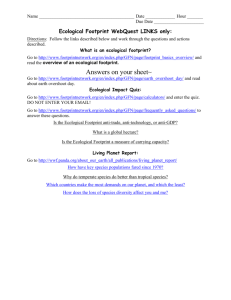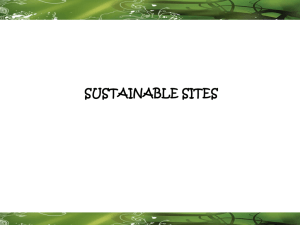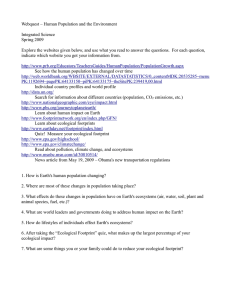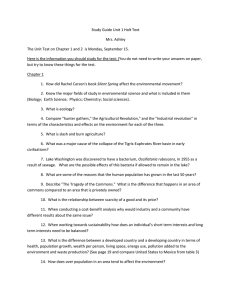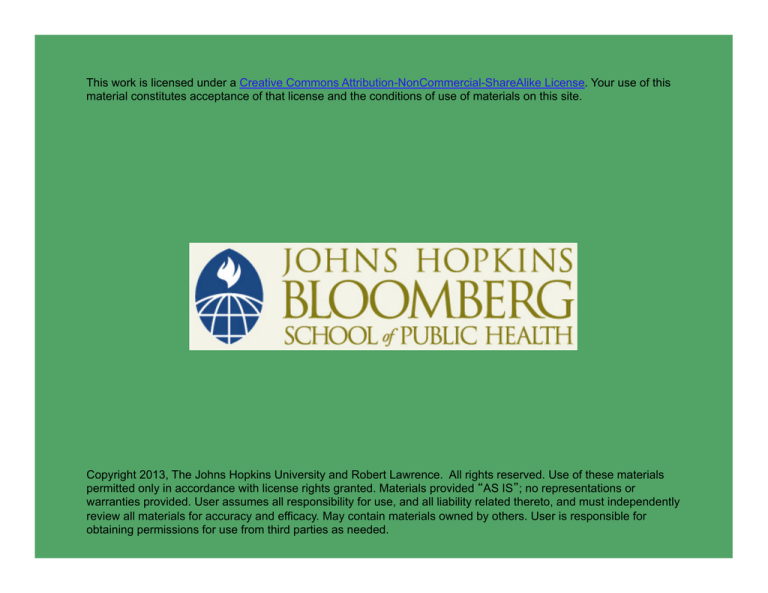
This work is licensed under a Creative Commons Attribution-NonCommercial-ShareAlike License. Your use of this
material constitutes acceptance of that license and the conditions of use of materials on this site.
Copyright 2013, The Johns Hopkins University and Robert Lawrence. All rights reserved. Use of these materials
permitted only in accordance with license rights granted. Materials provided “AS IS”; no representations or
warranties provided. User assumes all responsibility for use, and all liability related thereto, and must independently
review all materials for accuracy and efficacy. May contain materials owned by others. User is responsible for
obtaining permissions for use from third parties as needed.
Section B
Equity and Global Ecological Footprints
Equity: Sharing the World’s Resources
n
Global population: 7 billion as of October 2011
- Nearly 2 billion overweight or obese
- Almost 1 billion are undernourished
n
75% of the global population live in countries where resource
extraction and depletion has exceeded resource capital
n
Consumption of earth’s resources exceeds earth’s capacity and
ability to regenerate by 30%
n
Resource extraction will increase in newly emerging economies
-
n
Brazil, Russia, Indonesia, China, India, South Africa
“Over the last half century, humans have polluted or overexploited two-thirds of the earth’s ecological systems on which
life depends” (Millennium Ecosystem Assessment Synthesis Report)
3
Resources Important for Food Production
n
Water quality and quantity
n
Soil quality and quantity
n
Biodiversity—wild and domesticated
4
Water Scarcity
Areas of Physical and Economic Water Scarcity
Source: United Nations Environment Programme (UNEP).
5
Water Pollution—Chemical
Source: UNEP vital waste graphics. (2004).
6
Water Pollution—Excess Fertilizer
n
Location of dead zones
Source: Mongabay.com. Retrieved from http://news.mongabay.com/2010/0722-hance_deadzones_nasa.html
7
Soil Degradation
8
Iowa Loses Topsoil at an Unsustainable Rate
Reprinted with permission. Source: Environmental Working Group. (2010). Losing ground. Retrieved from:
http://www.ewg.org/losingground/index.html
9
Iowa Loses Topsoil at an Unsustainable Rate
Source: Environmental Working Group. (2010). Losing ground. Retrieved from:
http://www.ewg.org/losingground/index.html
10
Human Impacts on Biodiversity
1700
2000
2050
11
Inequitable Resource Use and Development
n
Industrialized countries, with 15% of the population, used 50% of the
fossil energy, industrial minerals, and metallic ores as of 2005
n
Between 1990 and 2006, total energy use in developing countries
increased by 40% while in high-income OECD countries it increased
by half as much
Sources: UNEP vital waste graphics. (2004); UN trends in sustainable development. (2010).
12
Ecological Footprints
Ecological Footprint Network estimates that three planets would be
needed now if every citizen were to adopt the UK lifestyle, and five
planets if they were to adopt the average North American lifestyle
Number of Earths
n
Source: Global Footprint Network. Retrieved from http://www.footprintnetwork.org/en/index.php/GFN/
13
Biocapacity
n
Biological capacity or biocapacity: the capacity of ecosystems to
produce useful biological materials and to absorb carbon dioxide
generated by humans, using current management schemes and
extraction technologies
Source: Global Footprint Network. Retrieved from http://www.footprintnetwork.org/en/index.php/GFN/
14
Biocapacity Used by Humans: 1961
Source: Global Footprint Network. Retrieved from http://www.footprintnetwork.org/en/index.php/GFN/
15
Biocapacity Used by Humans: 2007
Source: Global Footprint Network. Retrieved from http://www.footprintnetwork.org/en/index.php/GFN/
16
Ecological Debt
17
Lecture 1 Exercise
n
Calculate your own footprint on the Global Footprint Network’s
Web site and share your results with us on the BBS:
http://www.footprintnetwork.org/en/index.php/GFN/page/
calculators/
18

